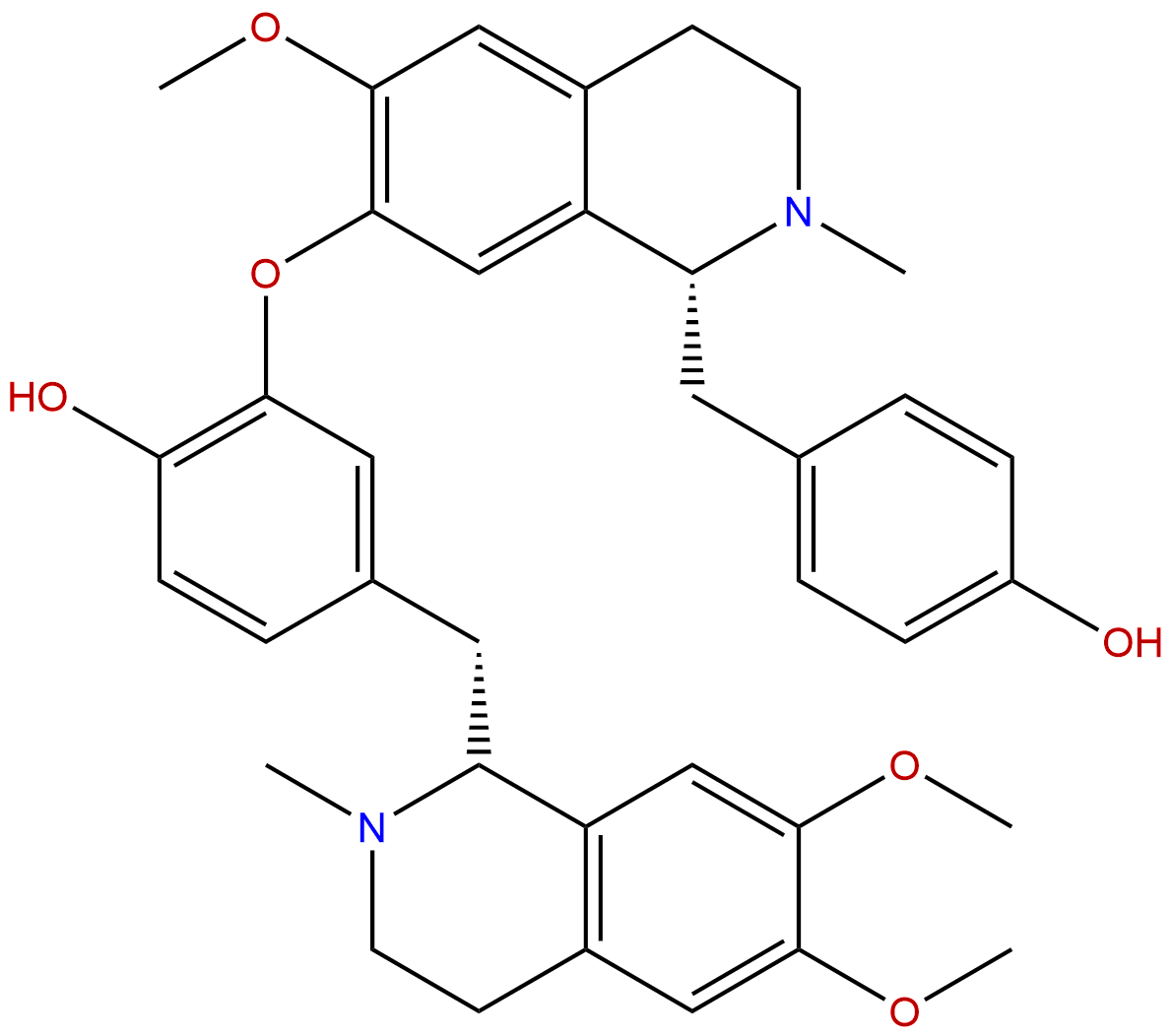
LiensinineCAS No.:2586-96-1
|
||||||||||
 |
|
|
||||||||

| Catalogue No.: | BP0858 |
| Formula: | C37H42N2O6 |
| Mol Weight: | 610.751 |
Synonym name:
Catalogue No.: BP0858
Cas No.: 2586-96-1
Formula: C37H42N2O6
Mol Weight: 610.751
Botanical Source: Alkaloid from seed embryo of Nelumbo nucifera (East Indian lotus) (Nelumbonaceae)
Purity: 95%~99%
Analysis Method: HPLC-DAD or/and HPLC-ELSD
Identification Method: Mass, NMR
Packing: Brown vial or HDPE plastic bottle
Can be supplied from milligrams to grams.
For Reference Standard and R&D, Not for Human Use Directly.
Inquire for bulk scale.
Description:
Liensinine is a human ether-a-go-go-related gene (hERG) inhibitor and a novel autophagy/mitophagy inhibitor, which can antagonize the ventricular arrhythmias. It exerts remarkable effect against thrombosis and possesses strong effect against platelet aggregation and coagulation.
References:
Zhongguo Zhong Yao Za Zhi. 2013 Jan;38(2):239-44.
[Effect of berberine, liensinine and neferine on HERG channel expression].
Immunofluorescence and Western blot methods were adopted for qualitative and quantitative detections of the effect of different concentrations of berberine, Liensinine and neferine on the expression of stable transfection in HERG potassium channel in HEK-293 cells, as well as the effect of different concentrations of berberine on protein expression of Ikr channel in cardiac muscular tissues, in order to investigate the anti-arrhythmic mechanism of berberine, Liensinine and neferine.
METHODS AND RESULTS:
Western blot method was used to detect protein expression of HERG channel in HERG-HEK cells. Immunofluorescence method as well as confocal laser microscope were used to detect the effect of different concentrations of berberine, Liensinine and neferine on protein expression of HERG channel. Western blot method was used to detect the effect of different concentrations of berberine on protein expression of Ikr channel in cardiac muscular tissues as well as the effect of berberine, Liensinine and neferine on protein expression of stable transfection in HERG potassium channel in HEK-293 cells. Western blot experiment manifested that stable transfection of HEK293 cells containing HERG genes could increase protein expression of HERG channel. Berberine (10, 30 micromol x L(-1)) remarkably inhibited protein expression of HERG channel in HERG-HEK cells (P < 0.01). Berberine (10, 20 mg x kg(-1)) also inhibited protein expression of Ikr channel in rat ventricular tissues (P < 0.05). Liensinine (3, 10, 30 micromol x L(-1)) increased protein expression of HERG channel in HERG-HEK cells (P < 0.05). Neferine showed no effect on protein expression of HERG channel in HERG-HEK cells.
CONCLUSIONS:
The stably transfection of HERG-HEK cells can increase protein expression of HERG channel. Berberine shows inhibitory effect on protein expressions of in vitro HERG-HEK cells and Ikr channel in rat ventricular tissues. Liensinine improves protein expression of HERG channe in HERG-HEK cells. Neferine shows no effect on protein expression of HERG channel.
Autophagy. 2015;11(8):1259-79.
A novel autophagy/mitophagy inhibitor liensinine sensitizes breast cancer cells to chemotherapy through DNM1L-mediated mitochondrial fission.
Autophagy inhibition has been widely accepted as a promising therapeutic strategy in cancer, while the lack of effective and specific autophagy inhibitors hinders its application.
METHODS AND RESULTS:
Here we found that Liensinine, a major isoquinoline alkaloid, inhibits late-stage autophagy/mitophagy through blocking autophagosome-lysosome fusion. This effect is likely achieved via inhibiting the recruitment of RAB7A to lysosomes but not to autophagosomes. We further investigated the effects of autophagy inhibition by Liensinine on the therapeutic efficacy of chemotherapeutic drugs and found that cotreatment of Liensinine markedly decreased the viability and increased apoptosis in breast cancer cells treated with various chemotherapeutic agents. Mechanistically, we found that inhibition of autophagy/mitophagy by Liensinine enhanced doxorubicin-mediated apoptosis by triggering mitochondrial fission, which resulted from dephosphorylation and mitochondrial translocation of DNM1L. However, blocking autophagosome/mitophagosome formation by pharmacological or genetic approaches markedly attenuated mitochondrial fission and apoptosis in cells with combinatatorial treatment. Moreover, Liensinine was synergized with doxorubicin to inhibit tumor growth in MDA-MB-231 xenograft in vivo.
CONCLUSIONS:
Our findings suggest that Liensinine could potentially be further developed as a novel autophagy/mitophagy inhibitor, and a combination of Liensinine with classical chemotherapeutic drugs could represent a novel therapeutic strategy for treatment of breast cancer.
HPLC of Liensinine
